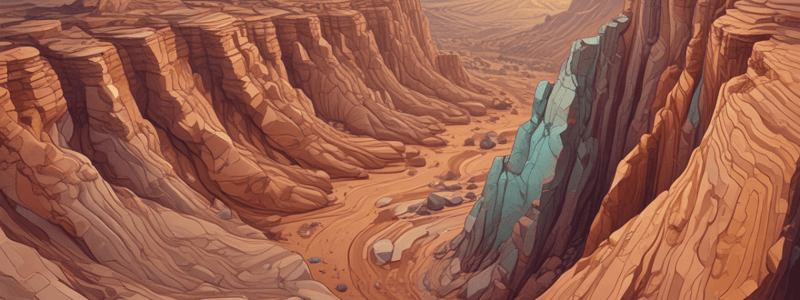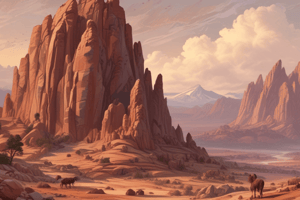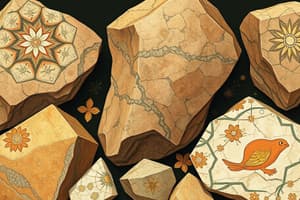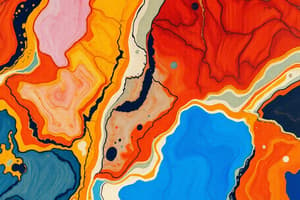Podcast
Questions and Answers
What is the process that breaks down rocks into smaller particles?
What is the process that breaks down rocks into smaller particles?
- Deposition
- Compaction
- Weathering (correct)
- Erosion
What type of rocks are formed from the cooling and solidification of magma or lava?
What type of rocks are formed from the cooling and solidification of magma or lava?
- Metamorphic rocks
- Igneous rocks (correct)
- Transformed rocks
- Sedimentary rocks
What is the process that transports sediments to new locations?
What is the process that transports sediments to new locations?
- Erosion (correct)
- Weathering
- Compaction
- Deposition
What is the result of sediment compaction and cementation?
What is the result of sediment compaction and cementation?
What type of rocks are formed from existing sedimentary or igneous rocks that undergo changes due to heat and pressure?
What type of rocks are formed from existing sedimentary or igneous rocks that undergo changes due to heat and pressure?
What is the process that occurs when sediments settle out of water or wind?
What is the process that occurs when sediments settle out of water or wind?
What drives the continuous rock cycle?
What drives the continuous rock cycle?
What is the characteristic of metamorphic rocks?
What is the characteristic of metamorphic rocks?
What is the term for the breaking down of rocks on the Earth's surface?
What is the term for the breaking down of rocks on the Earth's surface?
What is the process that transforms solid rock into molten rock?
What is the process that transforms solid rock into molten rock?
What type of rock is formed from the cooling and solidification of magma or lava?
What type of rock is formed from the cooling and solidification of magma or lava?
What is the term for the movement of sediment or rock fragments from one location to another?
What is the term for the movement of sediment or rock fragments from one location to another?
What is the process that settles or deposits sediment?
What is the process that settles or deposits sediment?
What is the term for the process by which sediments are pressed together under their own weight?
What is the term for the process by which sediments are pressed together under their own weight?
What type of rock is formed from the compaction and cementation of sediments?
What type of rock is formed from the compaction and cementation of sediments?
What is the primary reason for the continuous transformation of rocks in the rock cycle?
What is the primary reason for the continuous transformation of rocks in the rock cycle?
What is the term for the process by which dissolved minerals crystallize and glue particles of sediment together into one mass?
What is the term for the process by which dissolved minerals crystallize and glue particles of sediment together into one mass?
What type of rock is characterized by having layers and may contain fossils?
What type of rock is characterized by having layers and may contain fossils?
What is the result of the processes of weathering, erosion, and deposition?
What is the result of the processes of weathering, erosion, and deposition?
What drives the transformation of sedimentary rocks into metamorphic rocks?
What drives the transformation of sedimentary rocks into metamorphic rocks?
What is the primary characteristic of igneous rocks?
What is the primary characteristic of igneous rocks?
What is the term for the series of processes that repeat in a sequence?
What is the term for the series of processes that repeat in a sequence?
What is the primary mechanism that drives the transformation of sedimentary rocks into metamorphic rocks?
What is the primary mechanism that drives the transformation of sedimentary rocks into metamorphic rocks?
What determines the size of crystals in igneous rocks?
What determines the size of crystals in igneous rocks?
What is the result of the continuous rock cycle?
What is the result of the continuous rock cycle?
What type of rocks can be formed from the compacted and cemented sediments?
What type of rocks can be formed from the compacted and cemented sediments?
What is the common process that occurs in the formation of both sedimentary and igneous rocks?
What is the common process that occurs in the formation of both sedimentary and igneous rocks?
What is the primary difference between intrusive and extrusive igneous rocks?
What is the primary difference between intrusive and extrusive igneous rocks?
What happens to sediments that settle out of water or wind?
What happens to sediments that settle out of water or wind?
What is the ultimate fate of rocks that undergo weathering and erosion?
What is the ultimate fate of rocks that undergo weathering and erosion?
What is the primary mechanism that drives the transformation of rocks from one type to another in the rock cycle?
What is the primary mechanism that drives the transformation of rocks from one type to another in the rock cycle?
Which of the following is a characteristic of sedimentary rocks?
Which of the following is a characteristic of sedimentary rocks?
What is the term for the process by which sediments are pressed together under their own weight?
What is the term for the process by which sediments are pressed together under their own weight?
What is the result of the continuous rock cycle?
What is the result of the continuous rock cycle?
Which of the following is NOT a type of rock?
Which of the following is NOT a type of rock?
What is the process that occurs when sediments settle out of water or wind?
What is the process that occurs when sediments settle out of water or wind?
What is the term for the process by which rocks are broken down into smaller particles?
What is the term for the process by which rocks are broken down into smaller particles?
What is the primary mechanism that drives the transformation of sedimentary rocks into igneous rocks?
What is the primary mechanism that drives the transformation of sedimentary rocks into igneous rocks?
Which of the following processes is not directly involved in the formation of sedimentary rocks?
Which of the following processes is not directly involved in the formation of sedimentary rocks?
What is the primary characteristic that distinguishes metamorphic rocks from sedimentary rocks?
What is the primary characteristic that distinguishes metamorphic rocks from sedimentary rocks?
Which of the following types of rocks can be formed from the cooling and solidification of magma or lava at the Earth's surface?
Which of the following types of rocks can be formed from the cooling and solidification of magma or lava at the Earth's surface?
What is the primary reason why rocks are able to undergo continuous transformation in the rock cycle?
What is the primary reason why rocks are able to undergo continuous transformation in the rock cycle?
What determines the size of the crystals in igneous rocks?
What determines the size of the crystals in igneous rocks?
What is the primary process that drives the formation of sedimentary rocks from sediments?
What is the primary process that drives the formation of sedimentary rocks from sediments?
What is the ultimate fate of rocks that undergo weathering and erosion?
What is the ultimate fate of rocks that undergo weathering and erosion?




